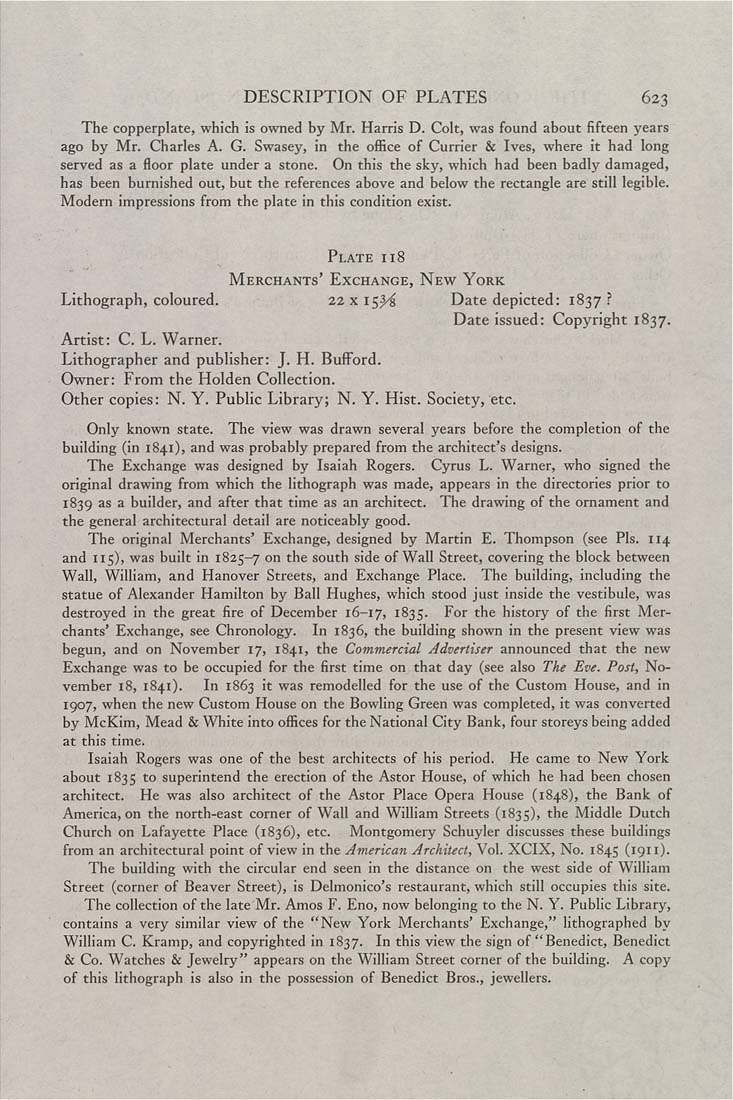DESCRIPTION OF PLATES 623
The copperplate, which is owned by Mr. Harris D. Colt, was found about fifteen years
ago by Mr. Charles A. G. Swasey, in the office of Currier & Ives, where it had long
served as a floor plate under a stone. On this the sky, which had been badly damaged,
has been burnished out, but the references above and below the rectangle are stiU legible.
Modern impressions from the plate In this condition exist.
Plate ii8
Merchants' Exchange, New York
Lithograph, coloured. 22x15^ Date depicted: 1837?
Date issued: Copyright 1837.
Artist: C. L. Warner,
Lithographer and publisher: J. H. Bufford.
Owner: From the Holden Collection.
Other copies: N. Y. Public Library; N. Y. Hist. Society, etc.
Only known state. The view was drawn several years before the completion of the
building (in 1841), and was probably prepared from the architect's designs.
The Exchange was designed by Isaiah Rogers. Cyrus L. Warner, who signed the
original drawing from which the lithograph was made, appears in the directories prior to
1839 as a builder, and after that time as an architect. The drawing of the ornament and
the general architectural detail are noticeably good.
The original Merchants' Exchange, designed by Martin E. Thompson (see Pis, 114
and 115), was built in 1825-7 on the south side of Wall Street, covering the block between
Wall, William, and Hanover Streets, and Exchange Place. The building, Including the
statue of Alexander Hamilton by Ball Hughes, which stood just inside the vestibule, was
destroyed in the great fire of December 16-17, i^SS* Por the history of the first Mer¬
chants' Exchange, see Chronology. In 1836, the building shown in the present view was
begun, and on November 17, 1841, the Commercial Advertiser announced that the new
Exchange was to be occupied for the first time on that day (see also The Eve. Post, No¬
vember 18, 1841). In 1863 it was remodelled for the use of the Custom House, and In
1907, when the new Custom House on the Bowling Green was completed. It was converted
by McKIm, Mead & White into offices for the National City Bank, four storeys being added
at this time.
Isaiah Rogers was one of the best architects of his period. He came to New York
about 1835 to superintend the erection of the Astor House, of which he had been chosen
architect. He was also architect of the Astor Place Opera House (1848), the Bank of
America, on the north-east corner of Wall and William Streets (1835), the Middle Dutch
Church on Lafayette Place (1836), etc, Montgomery Schuyler discusses these buildings
from an architectural point of view in the American Architect, Vol. XCIX, No, 1845 (1911).
The building with the circular end seen In the distance on the west side of William
Street (corner of Beaver Street), is Delmonlco's restaurant, which still occupies this site.
The collection of the late Mr. Amos F. Eno, now belonging to the N. Y, Public Library,
contains a very similar view of the "New York Merchants' Exchange," lithographed by
William C. Kramp, and copyrighted in 1837. In this view the sign of "Benedict, Benedict
& Co. Watches & Jewelry" appears on the WiUIam Street corner of the building. A copy
of this lithograph is also in the possession of Benedict Bros., jewellers.
i
|








